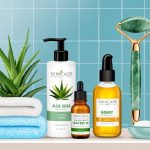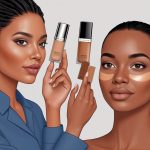How to Choose the Right Foundation Shade for Your Skin Tone: Expert Makeup Tips
Types of Foundation and Coverage Options
Choosing the right foundation involves understanding different formulas and coverage levels. The texture, finish, and application method can greatly influence how foundation looks and feels on the skin.
Powder vs. Liquid Foundation
Powder foundation is favored for oily or combination skin types because it helps control shine and offers a matte finish. Its lightweight texture makes it easy for quick touch-ups throughout the day.
Many people prefer powder foundation during hot weather due to its ability to absorb excess oil. Liquid foundation provides more versatility in terms of coverage and finish.
Available in formulas ranging from dewy to matte, liquid foundations can suit dry, normal, or combination skin. This type easily blends into the skin, offering a natural look for light coverage or a flawless look with heavier layering.
When deciding between powder and liquid, consider skin type and desired finish. Powder options are quick and convenient, while liquid foundations are suitable for those seeking buildable or more customizable coverage.
For more detail on finding the right type for your needs, visit this guide to foundation shade and formula selection.
Understanding Medium and Full Coverage
Medium coverage foundation helps even out skin tone while still allowing some natural skin features, like freckles, to show through. This coverage is suitable for people who want a more polished, everyday look without feeling too heavy.
Medium coverage is adaptable and less likely to accentuate fine lines or texture, making it suitable for various skin types. Full coverage foundation is designed for those seeking to completely conceal blemishes, discoloration, or redness.
This type offers an opaque finish and is often used for special events, photography, or when a flawless complexion is desired. It may be heavier and might require thorough blending to ensure a smooth, natural appearance.
Product choice can impact both the look and comfort of your makeup, as explained in this article on foundation coverage options.
The Benefits of Buildable Coverage
Buildable coverage foundation allows users to layer the product for a customized result. This makes it easy to start with a lightweight application and add more as needed, targeting areas that require extra attention.
Buildable formulas prevent a cakey or mask-like effect since each layer adheres smoothly. This type of foundation is particularly useful for people whose skin needs change throughout the day or in different environments.
Its flexibility means users can adapt their foundation for a sheer daytime finish or a more perfected evening look. Buildable coverage also helps address skin concerns without sacrificing a natural finish.
Layering foundation in thin coats allows for precise control, balancing coverage and comfort. It’s especially helpful for those who want the option to adjust their look without starting over.
For tips on applying multiple thin layers to achieve seamless results, references like this expert foundation advice can provide guidance.
Expert Tips for Achieving a Flawless Foundation Match
Achieving a flawless foundation match involves combining correct technique with careful testing. With a few targeted steps, anyone can significantly improve their chances of finding the perfect shade for a natural, flawless complexion.
Blending Techniques for Seamless Results
For a truly seamless foundation match, it’s essential to blend foundation into the skin using proper tools and skills. Always start with a clean, moisturized face to help the product glide and avoid patchiness.
Using a damp makeup sponge or foundation brush, gently tap and press the foundation onto the skin instead of dragging or rubbing it. The foundation should be blended from the center of the face outward, making sure to reach the hairline, jawline, and even slightly onto the neck for a smooth transition.
Pay attention to areas around the nose and mouth, as product can settle there and disrupt a flawless finish. Layer thin amounts and build up coverage gradually rather than applying one heavy layer.
For more on these techniques, check the detailed blending guidance at InStyle.
Spot Testing and Wear Tests
Proper foundation match requires thorough spot testing and time-based wear tests. Begin by swiping a small amount of foundation on the side of the jawline and comparing it to the skin tone in both natural and artificial lighting.
Test two or three similar shades with different undertones, and allow each swatch to sit for a minute to adjust to the skin. A good foundation match should disappear into the skin, showing no obvious line of demarcation.
Take it further by wearing the best-matched shade for several hours to evaluate how it holds up, especially in areas prone to oil or dryness. Oxidation can cause color shifts, so check the appearance after a few hours.
Detailed expert advice on spot testing is available in resources like the YSL Beauty guide and Real Simple.
Frequent wear tests help identify the perfect foundation match for long-lasting, natural-looking results.



